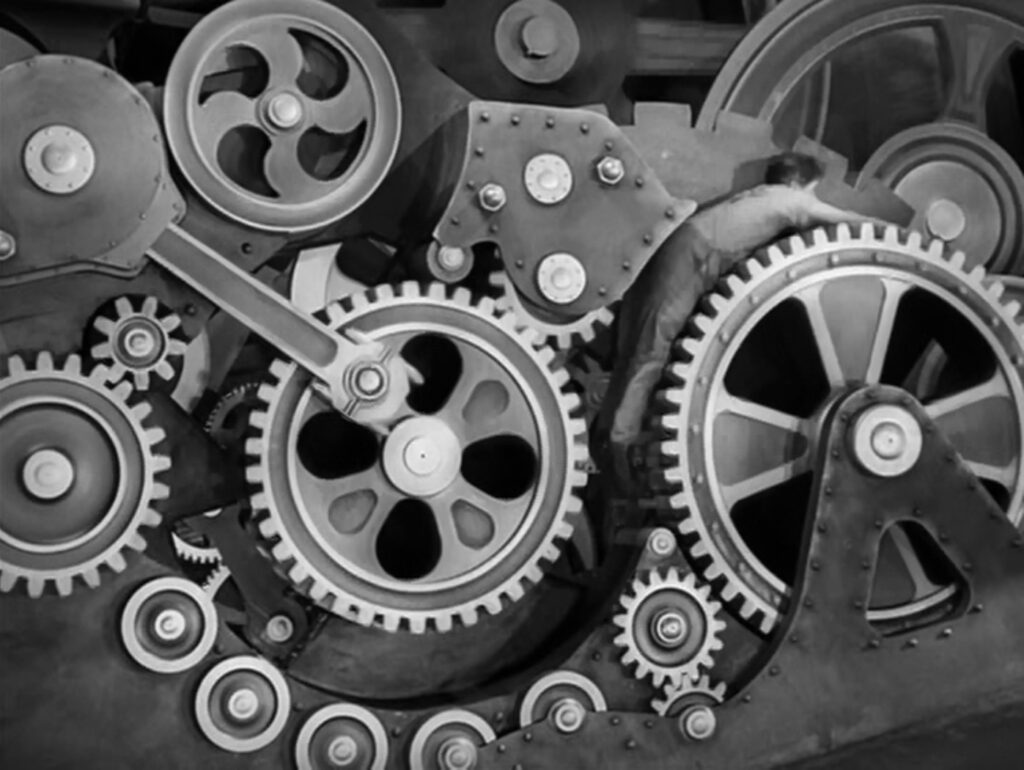
Modern Times
1936, directed by Charles Chaplin
Modern Times opens to a flock of sheep pressing forward then a crowd of commuters exiting a subway. The metaphor is pretty obvious, and anyone familiar with the Little Tramp will know exactly who the black sheep is going to be. If the film were nothing more than a social or economic critique of the modern world, then this opening would be unbearably blunt, but in fact the sheep are not the first image, and the film has a more philosophical critique in mind. Before the sheep, behind the titles, is a clock face – and as the title suggests, Modern Times is about time itself, an argument against a particular view of time that governs the industrialized world.
The clock face fills the rectangular screen, but the Roman numerals and the motion of the hands form a circle, which the crescent counterweight on the second hand reinforces. There will be a profusion of circles in the scenes ahead, but they are not distributed evenly. To be precise, there’s a tight correlation between circles and labor. The Tramp vacillates constantly between work and unemployment. We see him at five different jobs, and that’s where the circles are concentrated.
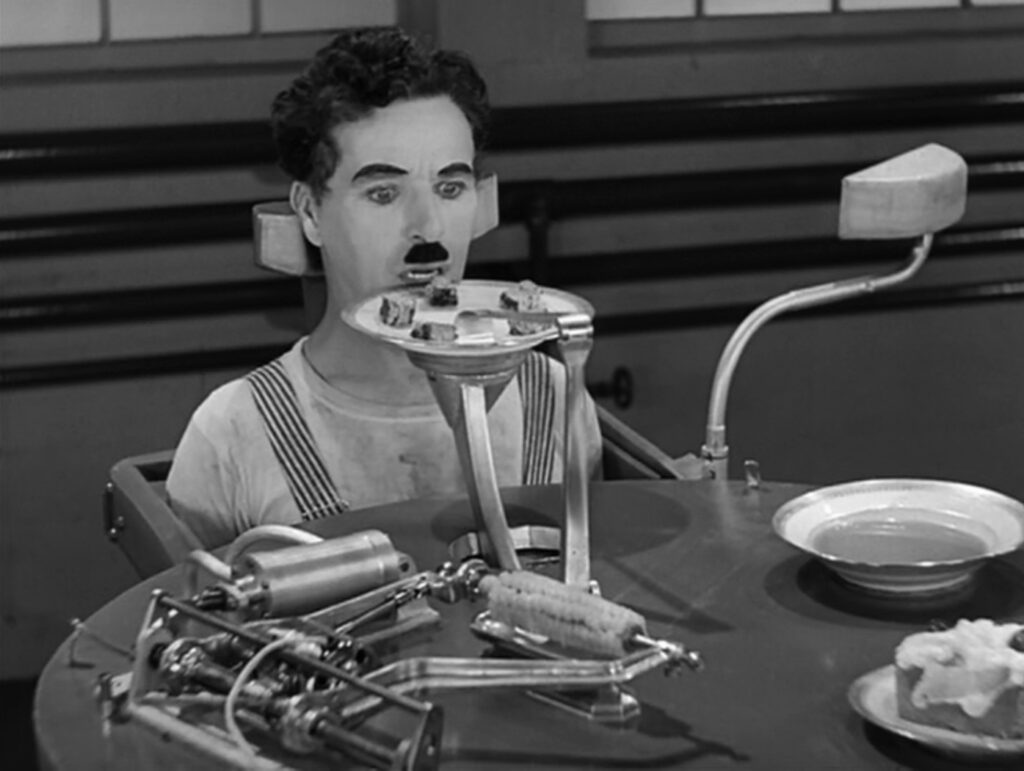
His first job is at a steel factory with circles everywhere – wheels, gears, buttons, dials, turbines, even the pair of bolts on steel plates that the Tramp must tighten so repetitively on the assembly line. The feeding machine that’s tested on him is a crazy assemblage of circular plates, bowls, and trays that turn in circular motions, including a spool for corn on the cob that goes into overdrive. The job drives the Tramp to his breaking point, making spasmic circular motions and chasing after round buttons on women’s dresses. Circles are also prominent at the department store – plates, jars, a cake holder, wine barrels, roller skate wheels, and the looping motion of the Tramp skating around. The second factory’s centerpiece is a massive set of gears and rollers. Finally, at the last workplace, dancers spin around in circles, the Tramp drills fake bubbles in a block of cheese, and waiters carry round plates on round trays to round tables, sometimes spinning like the dancers as they navigate the crowded floor.
Away from the workplace there are very few circles, and the dominant motion is linear. Protesters march through the streets, prisoners walk in single file, the Tramp and the Gamin run away from police or social workers. At the end they’ll walk down a straight highway.
The pattern is broken twice, but each breakage immediately restores the pattern. The only workplace without circles leads immediately to unemployment, and the only prominent circles outside the workplace lead immediately to jobs. The Tramp’s second job is at a shipyard where his first task is to look for a wooden wedge – a triangle. The task disorients him so much that he unwittingly sends an unfinished ship into the ocean and quits after barely a minute’s work. Conversely, after his second factory job the film cuts to a street scene with a spinning carousel and the gamin’s twirling dance. Those are the only major circles outside of work, and they segue immediately into jobs for both her and the Tramp.
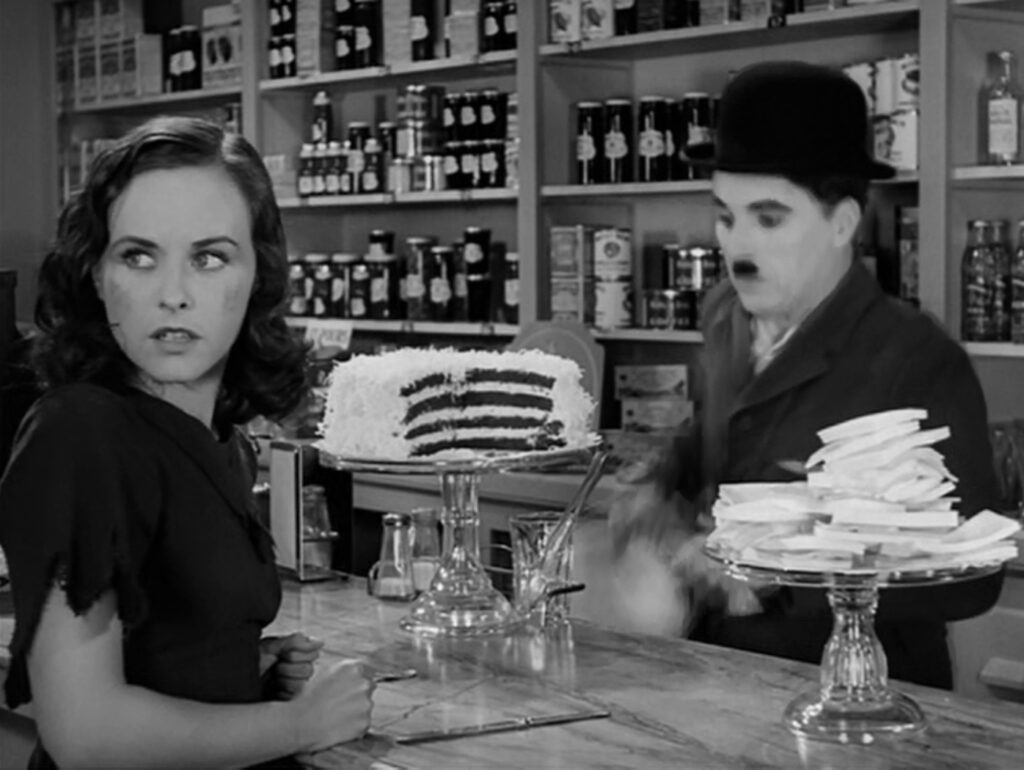
All the circles echo the big clock that starts the movie. They imply an oppressive vision of time – not the cyclical time of Eastern religions, but an internalized “clock time” in which hours and minutes weigh heavily on workers alienated from their own labor. The oppression of clocks gets handed down the generations, and most workers know nothing else. The mechanic at the second factory bemoans the flattening of his “family heirloom” pocketwatch, which the Tramp accidentally leaves in a steam press. Clock time becomes internalized, then it comes out in the twitching neurotic motion of the Tramp’s hands, in the repetitive punching of time cards, and in the orders to speed up production. In contrast, the big boss plays with a jigsaw puzzle in his office. Upper management clearly lives in a different mode of time.
The idea of alienated labor owes much to Karl Marx, and it clarifies Chaplin’s argument. Before industrialization, workers may or may not have been materially poorer, but their lives had a more tangible sense of meaning because their activity gave them a sense of creative control. A farmer or an artisan creates something from scratch, exercizing both mind and body, but a factory worker or a coal miner lacks that satisfaction of accomplishment. The insight of Modern Times is that this new way of life distorts a person’s sense of time, making life feel measured and mechanical. It strips life of its joy.
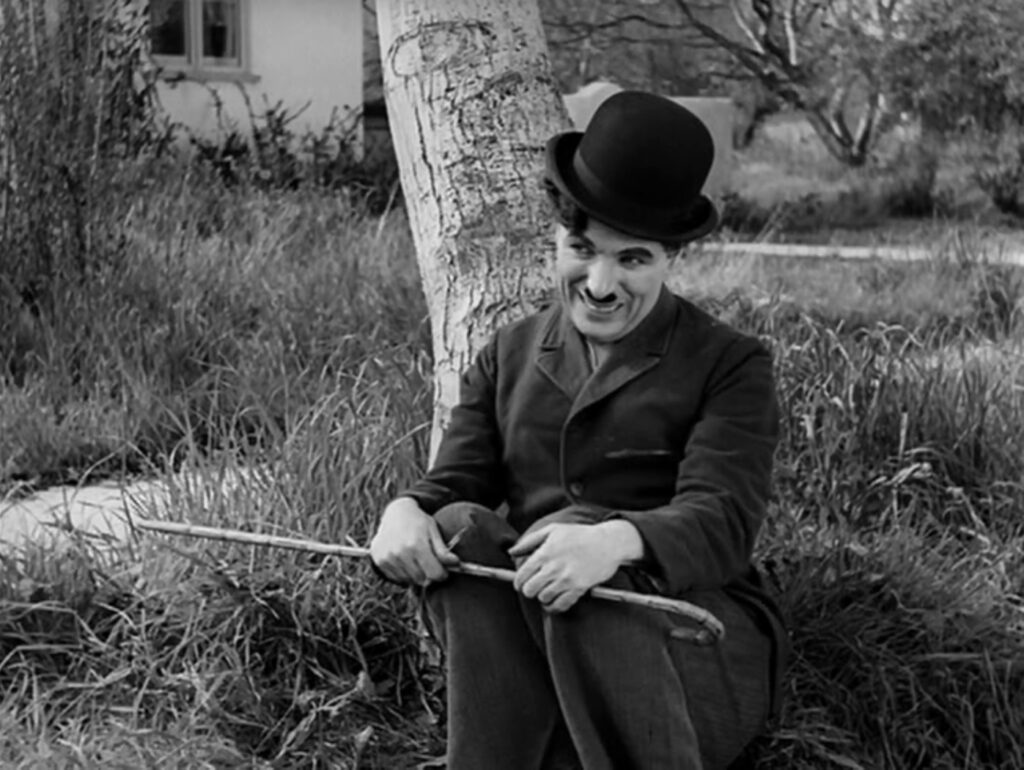
Of all the circles in Modern Times the most memorable is surely the gigantic set of gears the Tramp gets sucked into when he dives onto the conveyor belt. The force of that moment goes beyond its comic or iconic impression. For one thing, the Tramp’s journey through the machine is like an infant’s passage through the birth canal. He emerges reborn, a new man, unwilling to accept the life he had before. As soon as he comes out he begins creating chaos in the factory, living on his own terms. Even in prison he’s liberated, in the sense that he prefers his cell to life in the steel plant. He’ll return to work again and again, but never as the slave he was at the beginning. In each scene he’ll rely more and more on his own resources, until the climax at the dinner club when he invents his own language, replacing the clichéd words of his song with a nonsensical but delightful blend of English, Italian, and French that brings down the house.
A birth canal is not the only image suggested by the famous picture of the Tramp caught in the gears. It’s also like a digestive tract, swallowing the Tramp and spitting him out, the way industry consumes and discards its workers. The image joins a broader pattern of food in Modern Times, not always as a metaphor for exploitation or consumption, but grounding the film in the arena of economics, where daily bread stands for the basic elements of life. The Tramp and Big Bill sit in bowls of soup, and the Tramp gets his lunch from the feeding machine. There’s a lunch scene at the prison where the Tramp accidentally laces his food with cocaine. The Gamin steals bananas and a baguette. The Tramp and the minister’s wife get digestive problems in the waiting room. The Tramp gorges himself in a cafeteria to get himself arrested. The department store has cake, cheese, and wine. The Tramp and the Gamin enjoy fantasy meals in the bungalow and again in their hut, and their final job is in a restaurant. This preoccupation with food, and by extension with the struggle to keep living, must have resonated with audiences during the Great Depression.
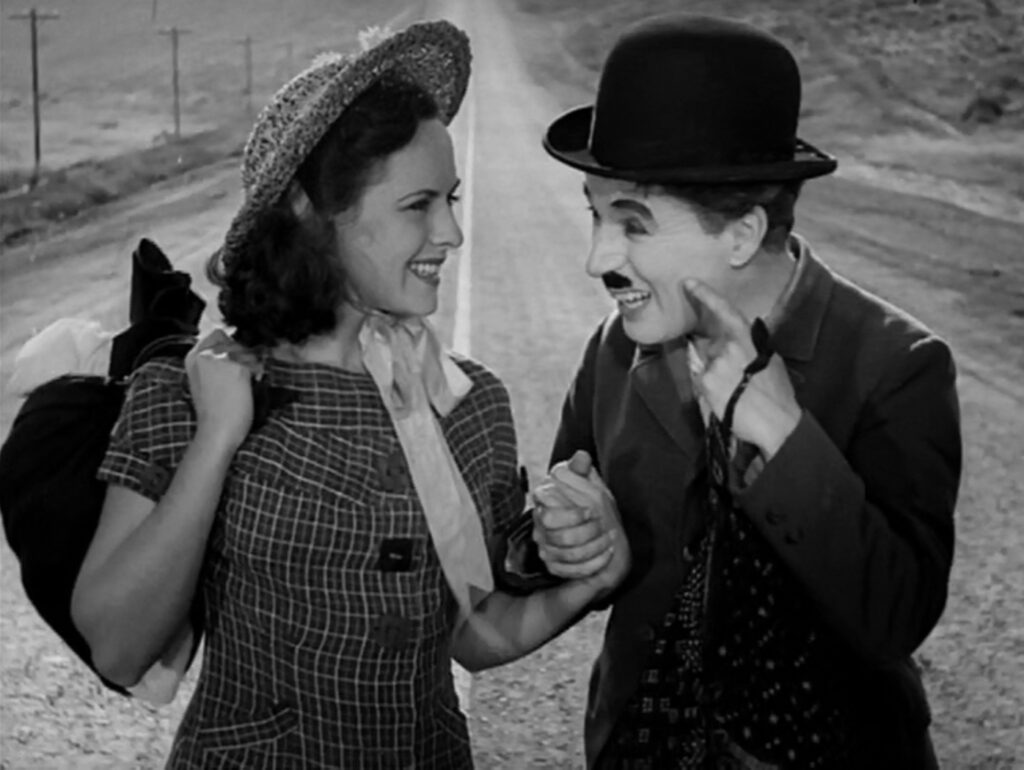
A film about an oppressive mode of life or an unlivable sense of time risks becoming tedious itself. Chaplin is adept at lightening the subject, but Modern Times also expresses the repetitiveness of modern life with its own repetitions, made palatable as much through variation as through comedy. In the Tramp’s second factory job his supervisor gets fed with a funnel and sucked into a machine, echoing what happened to the Tramp before. There are two strikes, three trips to jail, and two escapes from the police. The Tramp and the Gamin walk twice up a long straight street (once going to the bungalow and once at the end), and they play house thrice – in their imaginary bungalow, in the department store, and in their ramshackle hut – each time pretending to live a comfortable bourgeois life that throws their reality into relief.
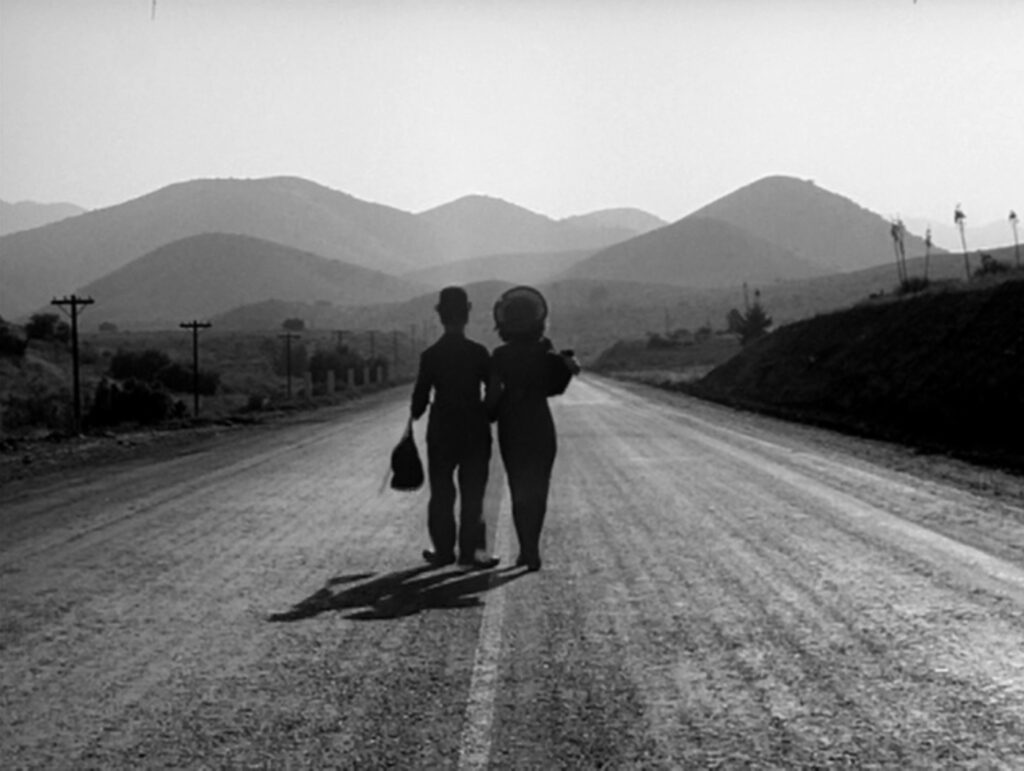
The fantasy scene in the suburban bungalow begins at the precise midpoint of Modern Times. The wall clock is set to noon, which can be either a tipping point or a kind of timeless ideal state. From there on the Tramp and the Gamin will join forces, striving to build a happy life together. Their happiness in the bungalow is imaginary, and their happiness at the end is left to the imagination. The ending is open, with no indicators of future troubles or future bliss. Its point is neither to comfort us nor to incite us, but to replace the dehumanizing clock time of modern working life with an alternate sense of time. It offers a taste of eternity, a state of life that’s not acutely conscious of the ticking of seconds, always waiting for the work bell to ring. As the couple walks into the distance they can finally hold onto the present moment and savor it.
CONNECTIONS:
Sherlock Jr. – Protagonist enters a symbolic womb and emerges reborn
City Lights – Second word of the title points to the film’s key
The Eighth Day of the Week – Couple suffering through hard economic times finds a semblance of happy domestic life in a department store
The Cook the Thief His Wife and Her Lover – Food as an economic metaphor